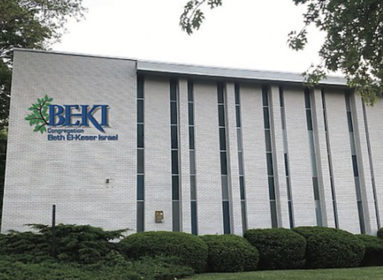By Jacob Kamaras/JNS.org
 New reports from the Pew Research Center and Brandeis University’s Steinhardt Social Research Institute (SSRI) estimate the Jewish population of the United States at 6.7 million and 6.8 million, respectively. Demographer Leonard Saxe, co-author of the SSRI report, believes the similarity of the reports paints a picture of stability that presents an opportunity to “get beyond the numbers” and instead focus on their implications.
New reports from the Pew Research Center and Brandeis University’s Steinhardt Social Research Institute (SSRI) estimate the Jewish population of the United States at 6.7 million and 6.8 million, respectively. Demographer Leonard Saxe, co-author of the SSRI report, believes the similarity of the reports paints a picture of stability that presents an opportunity to “get beyond the numbers” and instead focus on their implications.
Pew’s Religion and Public Life Project on Tuesday released “A Portrait of Jewish Americans,” based on a survey of 3,475 Jews from Feb. 20 to June 13, 2013. The report estimated that there are 6.7 million Jews in the U.S., and that 78 percent of that population identifies as Jewish by religion, as opposed to by background or other criteria. A day earlier, SSRI released “American Jewish Population Estimates: 2012,” which concluded that there are 6.8 million American Jews (or 2.2 percent of the total U.S. population), with about 81 percent identifying as Jewish by religion (1.8 percent of the population).
SSRI’s report was based on “data from hundreds of academic, government, and privately funded surveys that ask questions about religious and ethnic identification,” from 2006-2012. Saxe, the director of SSRI as well as the Cohen Center for Modern Jewish Studies, had estimated in December 2011 that the U.S. Jewish population was 6.4 million. Amid the release of the new figures, he said the population increase as well as the stabilization of the number of those identifying as Jewish by religion could be interpreted as either a positive or negative narrative, being that synagogue membership and engagement with other Jewish institutions have not risen at the same rate as the Jewish population.
“You can either say, ‘Wow, this is a problem,’ or you can say, ‘This is an opportunity for the Jewish community,’” Saxe told JNS.org. The Jewish community, he said, needs to “focus on this gap between people who identify with [Judaism], consider themselves Jewish, and those people who participate in the community.”
According to SSRI’s data, about 4.2 million American adults identify as Jewish when asked about their religion, and about 970,000 adults identify as Jewish by background or other criteria. Factoring in the report’s estimate of 1.6 Jewish children in the U.S., 1.3 million identifying as Jewish by religion, the percentage of American Jews identifying as Jewish by religion is about 81.
For the counting of Jewish adults, the SSRI and Pew results came “within a fraction of a fraction of a fraction” of each other, Saxe said. But part of the discrepancy between the reports’ total Jewish population estimates, he noted, stems from how Pew measured Jewish children. Pew identified 1.3 million children “in households with a Jewish adult who are being raised Jewish or partly Jewish.” SSRI’s report, meanwhile, identified about 300,000 more Jewish children.
“[Pew’s] definition of Jewish children is children who were being raised as Jewish children, but there are a lot of Jewish children who are not being sent to Hebrew school,” Saxe told JNS.org. “Twenty percent or more of the folks who go on Taglit (Birthright trips to Israel) are people who never step foot in a Hebrew school, never have a day of Jewish education. But because their parents are Jewish, they’re fully Jewish, and we accept them with open arms in the community.”
Saxe made an analogy to an American who doesn’t vote and doesn’t happily pay taxes, but would still be counted as an American. He said that young people, many without any Jewish education, are “claiming their Jewish identity when they’re given a good reason to do so, and they’re fully legitimate.”
The SSRI study said 24 percent of American Jews are 65 or older, and that American Jews are more than twice as likely as the rest of the population to be college graduates.
“We are an older population,” Saxe said. “Part of the reason is that, I think, people grow into accepting and claiming their Jewish identity.”
Jews also live for longer and are “naturally going to increase as a percentage of the population” because they are highly educated, he said.
 About 65 percent of American Jews reside in six states, according to the SSRI report, including: more than 20 percent in New York, followed by 14 percent in California, 12 percent in Florida, 8 percent in New Jersey, and 5 percent each in Massachusetts and Pennsylvania. For Jewish adults, more than 13 percent live in New York City, followed by about 9 percent in southern Florida, 8 percent in Los Angeles, 7 percent in New York City suburbs, and 4 percent in Boston, its western suburbs, and western Massachusetts.
About 65 percent of American Jews reside in six states, according to the SSRI report, including: more than 20 percent in New York, followed by 14 percent in California, 12 percent in Florida, 8 percent in New Jersey, and 5 percent each in Massachusetts and Pennsylvania. For Jewish adults, more than 13 percent live in New York City, followed by about 9 percent in southern Florida, 8 percent in Los Angeles, 7 percent in New York City suburbs, and 4 percent in Boston, its western suburbs, and western Massachusetts.
The fact that Jews are becoming more concentrated in a small group of urban areas is “a little counterintuitive, because with the Internet, and communications, and travel, and so on, you would think people could live anywhere,” Saxe said. Instead, Jews are migrating “to the intellectual centers, and the centers of innovation,” he said.
“They’re doing that because that’s where people with lots of education are congregating,” Saxe said.
Whether it be SSRI’s 6.8 million or Pew’s 6.7 million, the new reports paint a radically different picture from that of the National Jewish Population Survey (NJPS) of 2000, which estimated just 5.2 million American Jews and 3 million who identified as Jewish by religion. The 2000 survey counted fewer American Jews than the estimate of 5.5 million from the 1990 NJPS, which had followed a boom in Jewish immigration to the U.S. following the movement to free Soviet Jewry. Saxe said the 2000 numbers “painted a devastating portrait” which “led to people suggesting that in 2020, 2030, there’d be no Jews left.”
The newly released Jewish population estimates carry significance beyond the numbers, especially when it comes to American Jewish support for Israel, Saxe said.
“It’s really important, because if there’s only a group of less than 3 million people in America who are Jews, and it’s their religion, and they care about Israel, that’s a significantly different than if there are 5 million or 6 million who feel a connection, feel a sense of peoplehood, feel that they are part and have a direct stake in what happens ba’aretz (in the land of Israel),” he said.
SSRI consulted with Pew in a variety of ways on “A Portrait of Jewish Americans,” and Saxe served on the Pew report’s advisory committee.
“When you do a national Jewish population study, one of the problems is that Jews are so rare that you end up, especially in the non-coast areas, having to interview hundreds, thousands of people just to find a single Jewish person,” Saxe said. “And what we did [at SSRI] is based on our geographic analyses—but also looking at where there are synagogues, schools, et cetera—we helped [Pew] focus the study on the places where the Jewish population is.”
SSRI determined that being “data miners,” through the analyses of various surveys conducted from 2006-2012, was “the only way to gather a reasonable, accurate, reliable, number, is to synthesize hundreds of other studies,” according to Saxe. Along with the new population estimates, the institute on Monday unveiled an interactive map of the U.S. Jewish population.
“For me, the [Jewish population] number in some ways is less important than the fact that after six years of collecting data about surveys, where people are asked about their religion and ethnicity and so on, we have converged on a number and it looks pretty stable, and it allows us to even get these reliable estimates of states and communities,” Saxe said.







 Southern New England Jewish Ledger
Southern New England Jewish Ledger














